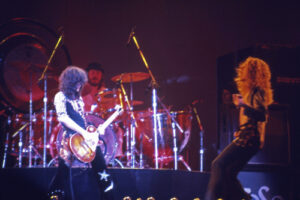
Feature Photo: Frank Okay
Television, once a revolutionary invention, took some time before becoming a ubiquitous part of daily life in American households. The earliest television broadcasts began in the late 1920s and early 1930s, but it wasn’t until the 1950s that TV sets became a common fixture in living rooms across the country. Families would gather around their black-and-white screens, marveling at this new medium that brought the outside world into their homes. By the 1960s, color television had arrived, adding vibrancy to the experience and cementing television’s role as a dominant cultural force.
As the decades progressed, TV technology advanced. In the 1970s, Cablevision began offering viewers more choices, expanding the number of channels beyond the basic network offerings. The 1980s and early 1990s saw an explosion of cable TV with specialized channels, sports networks, and round-the-clock news. This content expansion inspired Bruce Springsteen’s iconic song “57 Channels (And Nothin’ On),” a commentary on the increasing number of options. By the late 1990s and early 2000s, 500 channels became a reality with the rise of digital cable and satellite television, making Springsteen’s once-sardonic observation seem quaint.
As TV evolved, so did its cultural impact. The way television infiltrated our lives became a recurring theme in rock music, which often served as a commentary on society’s relationship with this powerful medium. From Gil Scott-Heron’s warning about the revolution not being televised to Dire Straits’ critique of MTV culture in “Money for Nothing,” musicians used television as both inspiration and a target of criticism. This list of the 10 Best Rock Songs About Television highlights the complex relationship between rock music and the ever-present force of television, exploring its influence on society, entertainment, and the individual experience over the decades.
# 10 – The Revolution Will Not Be Televised – Gil Scott-Heron
Released in 1970 as part of the spoken-word album Small Talk at 125th and Lenox, “The Revolution Will Not Be Televised” by Gil Scott-Heron became a cultural landmark, blending jazz, poetry, and social commentary. The song, produced by Bob Thiele, was recorded at RCA Studios in New York City. Gil Scott-Heron’s powerful voice and his biting words cut through the complacency of mainstream media and television. He was able to encapsulate the frustration of the African American experience in the face of systemic oppression during a time of social and political upheaval. The track gained even more importance as it highlighted the limitations of mass media in addressing deeper societal issues, something that resonates even today.
The lyrics are rich with references to pop culture, politics, and social struggles. Scott-Heron’s message was clear—true change wouldn’t happen through passive consumption of media but by direct action and community involvement. Lines like, “The revolution will not be right back after a message about a white tornado, white lightning, or white people,” cleverly critique the way advertising and television often dilute or distract from important issues. The minimalist production of conga drums and the steady, rhythmic delivery of Scott-Heron’s spoken-word poetry offer a stark contrast to more traditionally structured songs, making “The Revolution Will Not Be Televised” an anthem of cultural resistance.
This song has been referenced and covered many times, reinforcing its place in rock and cultural history. Its influence is palpable in the works of politically conscious musicians like Public Enemy and Rage Against the Machine. Gil Scott-Heron’s song set a precedent for music being more than entertainment; it could serve as a call to action, a social commentary that stays relevant decades after its release.
Read More: Top 10 Gil Scott-Heron Songs
# 9 – Turn It On Again – Genesis
Released in 1980 on the album Duke, “Turn It On Again” is a classic Genesis track that showcases the band’s transition from their progressive rock roots to a more radio-friendly, mainstream rock sound. The song was written by Tony Banks, Phil Collins, and Mike Rutherford, and produced by the band along with engineer David Hentschel. Recorded at Polar Studios in Stockholm, Sweden, the track stands out for its unusual time signatures, with the verses written in 13/8 time, a unique rhythm for a rock song. Despite its complex structure, “Turn It On Again” remains one of Genesis’ most successful and recognizable singles, peaking at number 8 on the UK Singles Chart and earning significant airplay worldwide.
Read More: Top 10 Genesis Songs
# 8 – Sleeping With The Television On – Billy Joel
Featured on Billy Joel’s 1980 Glass Houses album, “Sleeping With The Television On” is a lesser-known gem that reflects Joel’s sharp sense of humor and keen observational songwriting. The album, produced by Phil Ramone, was recorded at A&R Recording, Inc. in New York City. Glass Houses marked Joel’s foray into a more rock-oriented sound compared to his earlier piano-driven ballads, and “Sleeping With The Television On” fits squarely into this shift. While not released as a single, the track has gained respect over time for its clever lyrics and infectious pop-rock arrangement.
Read More: Top 10 Billy Joel Songs
# 7 – The Barry Williams Show – Peter Gabriel
Released in 2002 as part of Up, Peter Gabriel’s seventh studio album, “The Barry Williams Show” is a sharp critique of the tabloid-driven, exploitative nature of talk shows. The song takes its title from Barry Williams, the actor best known for playing Greg Brady on The Brady Bunch, but Gabriel uses the name metaphorically to comment on sensationalism in media. Produced by Gabriel and recorded at Real World Studios in Box, Wiltshire, the track features Gabriel’s signature layered sound with a mix of rock, electronica, and world music influences.
Read More: Top 10 Peter Gabriel Albums
# 6 – I’m The Slime – Frank Zappa
Released in 1973 on Frank Zappa’s album Over-Nite Sensation, “I’m The Slime” is a scathing indictment of television’s effect on society. Zappa, known for his avant-garde approach to music and biting social critiques, uses this track to take aim at the medium’s ability to manipulate and brainwash the masses. The song was recorded at Bolic Sound Studios in Inglewood, California, and produced by Zappa himself. “I’m The Slime” blends rock, jazz, and funk elements, showcasing Zappa’s eclectic style, with his guitar work and signature humorous, satirical lyrics at the forefront.
Read More: A Method in Exploring the Frank Zappa Album’s Catalog
# 5 – Prime Time – The Tubes
“Prime Time,” released in 1979 on Remote Control, is The Tubes’ satirical take on television’s overwhelming influence. Produced by Todd Rundgren, the album marked a significant shift in The Tubes’ sound, leaning towards a more conceptual approach to pop-rock. Recorded at Rundgren’s Utopia Sound in Lake Hill, New York, “Prime Time” delves into the idea of television as a controlling force, selling viewers an artificial sense of reality.
Read More: The Tubes – Unreleased Classic Rock Photos Vol.2 – The Mike Hill Series
# 4 – Video Killed the Radio Star – The Buggles
Released in 1979, “Video Killed the Radio Star” became an anthem for the changing landscape of music and media in the late 20th century. Written by Trevor Horn, Geoff Downes, and Bruce Woolley, the song appeared on The Buggles’ debut album The Age of Plastic. The track was recorded at Sarm East Studios in London, with production led by Horn and Downes. It achieved massive success, reaching number one on the UK Singles Chart and becoming a global hit. Its futuristic production and use of synthesizers marked the early days of the new wave genre.
Lyrically, the song laments the transition from radio to television as the dominant force in popular culture. The title itself symbolizes the impact that visual media, especially music videos, had on the music industry. Ironically, the song became even more iconic when its music video was the first ever aired on MTV on August 1, 1981.
Read More: Top 10 Songs By The Buggles
# 3 – TVC 15 – David Bowie
“TVC 15,” from David Bowie’s 1976 album Station to Station, reflects his fascination with technology, media, and the dystopian potential of both. The song, co-produced by Bowie and Harry Maslin, was recorded at Cherokee Studios in Los Angeles. Bowie’s 1976 work marked his transition from the glam rock of his earlier albums into more experimental, avant-garde territory. Station to Station is often viewed as one of Bowie’s most innovative records, and “TVC 15” exemplifies his ability to blend rock, soul, and electronic elements.
The song is centered around a surreal concept: a man whose girlfriend has been eaten by a television set. Bowie’s fascination with how media influences perception and reality comes through in the song’s bizarre lyrics and avant-garde sound, incorporating a mix of rock and cabaret-style piano. The track’s infectious groove contrasts with the bizarre and somewhat sinister subject matter, offering a commentary on the addictive, all-consuming nature of television.
Read More: 10 Most Underrated David Bowie Songs
# 2 – 57 Channels (And Nothin’ On) – Bruce Springsteen
Bruce Springsteen’s 1992 track “57 Channels (And Nothin’ On)” from the album Human Touch offers a stark critique of the increasing saturation of media and the sense of emptiness it creates. Recorded at A&M Studios in Los Angeles and produced by Springsteen alongside Jon Landau and Chuck Plotkin, the song uses a minimalist arrangement to highlight its message. The sparse bassline and Springsteen’s deadpan vocal delivery underscore the song’s frustration with the overwhelming yet unsatisfying options cable television provides.
The lyrics explore the paradox of having numerous entertainment options yet feeling disconnected and disengaged from all of them. The phrase “57 channels and nothing on” became a cultural catchphrase, encapsulating the growing sentiment of alienation in the media-saturated world. Compared to earlier songs like “TVC 15” by David Bowie, which explored the media’s surreal qualities, Springsteen’s approach is more direct and grounded in the day-to-day experience of modern life.
Read More: Top 10 Bruce Springsteen Hits
# 1 – Money for Nothing – Dire Straits
Released in 1985, “Money for Nothing” was a massive hit for Dire Straits, becoming one of the most iconic songs of the 1980s. Written by frontman Mark Knopfler and Sting, who provided the iconic “I want my MTV” vocal intro, the song appeared on the band’s album Brothers in Arms. Produced by Knopfler and Neil Dorfsman, it was recorded at AIR Studios in Montserrat. “Money for Nothing” dominated the charts, reaching number one on the Billboard Hot 100 and earning Dire Straits a Grammy for Best Rock Performance by a Duo or Group with Vocal..
Read More: Top 10 Dire Straits Songs



































